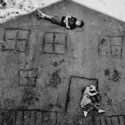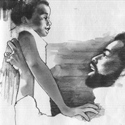 I am walking in Mount Oliver, a hilltop borough surrounded by the city of Pittsburgh, when I turn down a side street and see the building in the photo above. Living in Detroit, I am accustomed to corner shrines of stuffed animals, empty malt liquor bottles, and flowers taped to lampposts. I have seen half of the graffiti RIP murals between the Bay Area and Belfast. But I have never seen any piece of street art that blew me away like this one painted on a few plywood boards replacing the window of a vacant storefront:
I am walking in Mount Oliver, a hilltop borough surrounded by the city of Pittsburgh, when I turn down a side street and see the building in the photo above. Living in Detroit, I am accustomed to corner shrines of stuffed animals, empty malt liquor bottles, and flowers taped to lampposts. I have seen half of the graffiti RIP murals between the Bay Area and Belfast. But I have never seen any piece of street art that blew me away like this one painted on a few plywood boards replacing the window of a vacant storefront: The small piece of text on the right says simply, "In Loving Memory of a Brother Named Brice." The work is centered on one shirtless man looking skyward in anguish and holding the body of another man, presumably Brice:
The small piece of text on the right says simply, "In Loving Memory of a Brother Named Brice." The work is centered on one shirtless man looking skyward in anguish and holding the body of another man, presumably Brice: The tattoo reads: "I don't know what tomorrow holds but I know who holds tomorrow," a religious saying without attribution. I consider the limpness of the dead man's head against the resolute stiffness of the mourner's, his bald head against the mourner's halo-like afro, the way the grain of the wood is left above above the dead man's head like emanating light. I feel like I'm staring at a medieval allegory or one of the elder Bruegel's aphoristic paintings. A boy, the victim's son, perhaps, pulls against a scantily-clad woman, reaching in vain towards the dead man. The look on the young woman's face suggests she may have been his girl, and perhaps the mother of this child:
The tattoo reads: "I don't know what tomorrow holds but I know who holds tomorrow," a religious saying without attribution. I consider the limpness of the dead man's head against the resolute stiffness of the mourner's, his bald head against the mourner's halo-like afro, the way the grain of the wood is left above above the dead man's head like emanating light. I feel like I'm staring at a medieval allegory or one of the elder Bruegel's aphoristic paintings. A boy, the victim's son, perhaps, pulls against a scantily-clad woman, reaching in vain towards the dead man. The look on the young woman's face suggests she may have been his girl, and perhaps the mother of this child: Behind them, a witness yells into a cell phone, a cop seems poised in a fruitless search for the attacker, and then there is a woman, heavyset, her face sunk in grief, being comforted by another man. The dead man's mother?
Behind them, a witness yells into a cell phone, a cop seems poised in a fruitless search for the attacker, and then there is a woman, heavyset, her face sunk in grief, being comforted by another man. The dead man's mother? A white police officer casually holds an attacking German Shepard-like dog, long a symbol of police brutality:
A white police officer casually holds an attacking German Shepard-like dog, long a symbol of police brutality: The painting seems to be focused on mourning rather than vengeance, though the artist has chosen to show a separate scene of violence. Three heavily-armed men fire upon another with a handgun hiding behind a tree while a ghostly face oversees the action:
The painting seems to be focused on mourning rather than vengeance, though the artist has chosen to show a separate scene of violence. Three heavily-armed men fire upon another with a handgun hiding behind a tree while a ghostly face oversees the action: The artist seems to say that even while people suffer, the acts that cause further suffering do not stop. Along the cityscape in the upper-left corner, we even catch a Hitchcockian glimpse of the artist himself, painting a similar scene on a different building:
The artist seems to say that even while people suffer, the acts that cause further suffering do not stop. Along the cityscape in the upper-left corner, we even catch a Hitchcockian glimpse of the artist himself, painting a similar scene on a different building: The entire painting is done in this blueish-gray monochrome, except for the blood flowing from Brice's wounds at the center, the most striking part of the painting. The pietà is such a common theme in European and Christian art. The word itself comes from the Latin pietas, one of the core Roman virtues, untranslatable but something close to the prostration of one's self in duty to one's father or the gods. In medieval German and eastern Europe, pietà artists emphasized the gore of Christ's wounds.
The entire painting is done in this blueish-gray monochrome, except for the blood flowing from Brice's wounds at the center, the most striking part of the painting. The pietà is such a common theme in European and Christian art. The word itself comes from the Latin pietas, one of the core Roman virtues, untranslatable but something close to the prostration of one's self in duty to one's father or the gods. In medieval German and eastern Europe, pietà artists emphasized the gore of Christ's wounds. I stand there looking at this anonymous painting, trying not to wallow in all this pretension, aware of myself as the white boy who cannot possibly understand the world the painting represents, associating it only with ancient things, with art born of suffering, art from a time when men were far closer to suffering than most of us are today.
I stand there looking at this anonymous painting, trying not to wallow in all this pretension, aware of myself as the white boy who cannot possibly understand the world the painting represents, associating it only with ancient things, with art born of suffering, art from a time when men were far closer to suffering than most of us are today.
They say Alexander the Great lamented at the tomb of Achilles, not for the dead hero but for the lack of a Homer to herald his own mighty deeds. The painting may be slightly amateurish, fading across two rickety sheets of plywood in Mount Oliver, Pennsylvania. But who among us will have something so heartfelt and beautiful created to remember us when we're gone? If we're lucky, maybe a few lines in the local paper about our works and days, the names of those we'll leave behind. A wake full of uncomfortable people eager to move on with their lives.
Yeah, the painting is no Picasso. But I am almost breathless when I finally walk away.
Copyright © 2005-2016 Sweet Juniper Media, Inc.
All Rights Reserved.
All Rights Reserved.
"Sweet Juniper" is a registered trademark.
No unauthorized reuse.
No unauthorized reuse.
Categories
- Friday Morning Street Urchin Blogging ( 107 )
- Detroit ( 60 )
- SAHD ( 34 )
- photography ( 30 )
- Thursday Morning Wood ( 25 )
- Halloween ( 23 )
- Thrift ( 18 )
- abandoned places ( 18 )
- terrifying nixon-era children's books ( 16 )
- Reminiscin' ( 15 )
- Sweet Juniper Media ( 11 )
- Wendell ( 10 )
- Design ( 9 )
- San Francisco ( 9 )
- nature fights back ( 9 )
- sleep ( 9 )
- if you ain't dutch you ain't much ( 8 )
- sentimental ( 7 )
- Music ( 6 )
- Parody ( 6 )
- birth story ( 6 )
- scrappers ( 6 )
- Sweet Juniper Tunes ( 5 )
- lawyering ( 5 )
- Zoo ( 4 )
- elegant leisure ( 4 )
- language ( 3 )
- feral houses ( 2 )
- theme parks of the damned ( 2 )
- zombies ( 1 )
Archives
- November 2017 ( 2 )
- December 2016 ( 1 )
- November 2016 ( 2 )
- December 2015 ( 1 )
- November 2015 ( 2 )
- December 2014 ( 1 )
- October 2014 ( 2 )
- April 2014 ( 1 )
- December 2013 ( 2 )
- November 2013 ( 1 )
- October 2013 ( 1 )
- September 2013 ( 2 )
- July 2013 ( 2 )
- June 2013 ( 1 )
- April 2013 ( 1 )
- March 2013 ( 3 )
- February 2013 ( 1 )
- January 2013 ( 1 )
- December 2012 ( 2 )
- November 2012 ( 1 )
- October 2012 ( 4 )
- September 2012 ( 2 )
- August 2012 ( 2 )
- July 2012 ( 1 )
- June 2012 ( 3 )
- May 2012 ( 1 )
- April 2012 ( 2 )
- March 2012 ( 1 )
- February 2012 ( 2 )
- January 2012 ( 1 )
- December 2011 ( 3 )
- November 2011 ( 3 )
- October 2011 ( 5 )
- September 2011 ( 3 )
- August 2011 ( 4 )
- July 2011 ( 4 )
- June 2011 ( 2 )
- May 2011 ( 4 )
- April 2011 ( 6 )
- March 2011 ( 7 )
- February 2011 ( 4 )
- January 2011 ( 4 )
- December 2010 ( 5 )
- November 2010 ( 7 )
- October 2010 ( 5 )
- September 2010 ( 4 )
- August 2010 ( 5 )
- July 2010 ( 7 )
- June 2010 ( 5 )
- May 2010 ( 5 )
- April 2010 ( 5 )
- March 2010 ( 4 )
- February 2010 ( 5 )
- January 2010 ( 5 )
- December 2009 ( 6 )
- November 2009 ( 5 )
- October 2009 ( 8 )
- September 2009 ( 9 )
- August 2009 ( 6 )
- July 2009 ( 9 )
- June 2009 ( 8 )
- May 2009 ( 8 )
- April 2009 ( 8 )
- March 2009 ( 12 )
- February 2009 ( 11 )
- January 2009 ( 9 )
- December 2008 ( 11 )
- November 2008 ( 9 )
- October 2008 ( 14 )
- September 2008 ( 11 )
- August 2008 ( 11 )
- July 2008 ( 12 )
- June 2008 ( 10 )
- May 2008 ( 9 )
- April 2008 ( 8 )
- March 2008 ( 10 )
- February 2008 ( 15 )
- January 2008 ( 12 )
- December 2007 ( 9 )
- November 2007 ( 12 )
- October 2007 ( 11 )
- September 2007 ( 13 )
- August 2007 ( 11 )
- July 2007 ( 8 )
- June 2007 ( 12 )
- May 2007 ( 10 )
- April 2007 ( 10 )
- March 2007 ( 12 )
- February 2007 ( 14 )
- January 2007 ( 12 )
- December 2006 ( 11 )
- November 2006 ( 10 )
- October 2006 ( 13 )
- September 2006 ( 8 )
- August 2006 ( 13 )
- July 2006 ( 13 )
- June 2006 ( 15 )
- May 2006 ( 13 )
- April 2006 ( 9 )
- March 2006 ( 10 )
- February 2006 ( 3 )
- January 2006 ( 5 )
- December 2005 ( 2 )
- November 2005 ( 8 )
- October 2005 ( 4 )
- September 2005 ( 1 )
- July 2005 ( 3 )


























